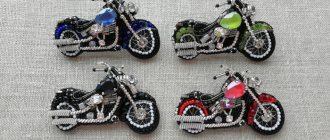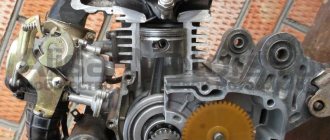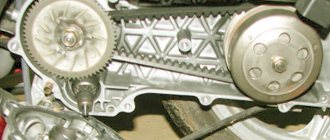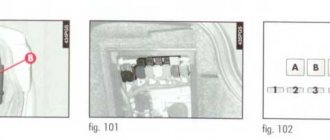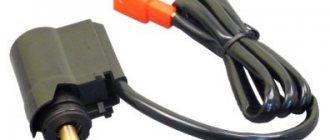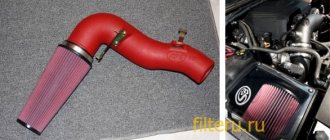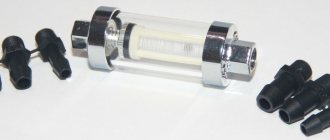When is replacement required?
High-quality scooter maintenance also depends on timely replacement of the air filter. This element performs an important function - it cleans the air that enters the carburetor. Oxygen then enters the engine along with the fuel mixture. If you hesitate a little, the transport will begin to function inferiorly, disobey its owner and become less playful. Another disadvantage is that if the purifier is clogged, the scooter will begin to consume more fuel, which, of course, will affect its maintenance.
Mechanics recommend changing the air filter on a 4 T scooter every 5 thousand kilometers. It will also be important to clean this element from dust and dirt. Cleaning should be done once every six months.
Cleaning the filter, changing the oil or changing individual system parts is required more often if the scooter is used daily for a long time. In this case, an inspection must be carried out every 500 kilometers. Such actions will eliminate costly repairs and the purchase of spare parts.
Signs that you need to replace the air filter in a 4T scooter:
- clogged appearance of the structure;
- change in technical characteristics of transport equipment:
- slow speed development, the engine does not start immediately, etc.
All these signs indicate that the engine is not getting enough air. It does not matter which scooter requires help (Chinese, homemade or Stealth scooter), the procedure for replacing the cleaner will be the same for each vehicle.
When to check your work?
Let's figure out in what cases it is necessary to check the operation of the scooter. For this you need:
periodic checks, cleaning, replacement of parts
With them, attention is directed to brittle, fragile parts; regular – parts sensitive to blockages. Dirt on them can lead to engine failure, overheating or jamming;. Maintenance leads to an extension of the life of motorcycle equipment
Maintenance leads to an extension of the life of motorcycle equipment
- current - when a violation is detected: rupture of connecting tubes, leakage of oil and the presence of stains from it, as well as cracks due to the influence of precipitation and temperature on the plastic;
- Preventive checks when changing oil, refueling, cleaning from dirt. Ignition and braking systems are also checked.
Preventive inspections and measures taken to replace unsuitable parts are important:
- fuel pump,
- gas tank,
- gasoline tap,
- fuel filter,
- air filter,
- carburetor,
- connecting tubes.
You can check the functionality of the fuel pump yourself.
Replacing the air filter on a scooter
The process of replacing the air structure on a scooter begins with determining its type and general characteristics. Another important feature is the location of the air filter.
There is a “wet” type filter, which is most often installed on Chinese models. There are also “dry” cleaners. The latter can often be found on scooters from Japan.
The “wet” filter, which is based on oil- and petrol-resistant foam, is impregnated with special oil.
The design consists of two layers:
- Internal. The material contains small cells that are capable of trapping even the smallest air pollutants;
- External. This layer has large cells that trap massive flows of dust.
The air purifier for the 4 T scooter is mounted in special boxes. This design can be located in front of the carburetor, above the muffler or variator.
Preparing for work
Selecting a suitable filter is the main preparatory stage before replacing the structure.
The main rule that will allow you to cope with the task efficiently is that you should not skimp on cleaners. It is better to purchase a more expensive but original version than a fake one. A scooter, like a motorcycle, must quickly respond to the driver’s actions and reach the required speed, which is only possible if you have a high-quality cleaning device. Required tools for replacement:
- crosshead screwdriver;
- socket wrench;
- pliers;
- clamp
This set of tools will be sufficient for routine filter replacement on a 4 T scooter.
The next step is preparing the new filter for installation. Additional impregnation will help the cleaner cope with its task to the maximum. This can be done using oil or a special chemical. If the choice falls on an aerosol, then it should be applied in linear movements over the entire surface of the filter. It is not recommended to make circular movements, as you should then wait 20 minutes and check the surface for the presence of unimpregnated areas.
Replacement process
Replacing the air filter on a 4 T scooter yourself is only possible if the driver carefully reads the regulations and prepares all the tools and the cleaner itself for the procedure.
You should start by removing the old filter. For this you need:
- For simplified access to the engine cleaning structure, remove all parts of the mechanism;
- Clean the housing from dirt and dust. Some boxes will have to be removed for this;
- Disassemble the case: unscrew the screws and remove the cover. This must be done carefully so as not to harm the filter;
- Retrieve the old element;
- Wash the body thoroughly to remove any dirt (you can use gasoline).
Step-by-step instructions for installing a new filter on a 4 T scooter:
- carefully check the new cleaner for defects;
- saturate the surface with liquid;
- install the device: the side with smaller pores is placed inside the structure;
- install the structure so that it fits tightly to the body and lid;
- Reassemble all dismantled parts in reverse order.
This process will not take much time, especially if the driver has experience in performing such work.
008_MOTO_0410_062
The “zero” filter consists of layers of non-woven material laid between two metal meshes and impregnated with a special sticky oil.
The finest dust simply sticks to the oil, while larger grains of sand get stuck in the gauze. The advantage of this design is the replacement of one dense filter layer with several less dense ones. The engine breathes easier and can add power at high revs. The disadvantage is the need for more frequent maintenance, somewhat less cleaning efficiency and expensive oil and cleaner. The “zero” filter consists of layers of non-woven material laid between two metal meshes and impregnated with a special sticky oil. The finest dust simply sticks to the oil, while larger grains of sand get stuck in the gauze. The advantage of this design is the replacement of one dense filter layer with several less dense ones. The engine breathes easier and can add power at high revs. The disadvantage is the need for more frequent maintenance, somewhat less cleaning efficiency and expensive oil and cleaner. Any intervention can have a very serious effect on engine performance. Also, never install alarm units, xenon headlight transformers, etc. inside the air filter housing. These warnings are based on life experience. One of my friends, for example, “to lighten the design” threw out the compensation chambers of the intake tract of the carburetor CBR1100XX. At the same time, the piston was bored out on the motorcycle, a sports jet set and a “gauze” filter were installed. After assembly, the motorcycle worked perfectly in place, but when picking up speed it immediately began to become terribly “poor.” Naturally, the reason was sought in the carburetor settings, filter and many other places. However, only the return of the intricately shaped tanks to their place instantly and completely cured the long-suffering “Drozd”.
So, the most popular filters among racers and simply tuning enthusiasts are “gauze”, multi-layer ones (they are also called “zero resistance” filters). They are distinguished from paper ones by the filter material itself and the method of its installation. If the purpose of installing a gauze filter is to improve the dynamic performance of the motorcycle, the following must be taken into account. Replacing a standard (paper) filter with a “gauze” filter without adjusting the carburetors often leads to a deterioration in engine performance, and not vice versa. An engine that receives more air (mainly at medium and high speeds) does not have enough gasoline, and running on a lean mixture, as we know, does not add power. And the carburetor vacuum flaps do not work quite correctly, since they are set at the factory to a different vacuum in the intake manifold. There are kits for adjusting the carburetors of popular sports motorcycles, but you will have to tinker with them if you want to get a really good result - to choose the best combination of jet diameter, needle lift height, quality screw speed.
Most modern motorcycles are equipped with fuel injection, so instead of adjusting the carburetors, you will need to change the injection control program. Companies specializing in tuning sports motorcycles produce programmable control units that allow you to enrich or lean the mixture using a computer, and change the ignition timing. In order not to get lost in the variety of settings, most motorcycles already have preset programs that take into account, among other things, the installation of “gauze” filters. Any intervention in the design of the motorcycle upsets the balance set by the factory engineers, so be prepared to gain in one area (for example, power at maximum speed), but lose in another (for example, traction in the mid-range). However, many people tune their motorcycle “out of love for art”
In this case, the main thing is not to do any harm, and how much the device was actually improved is not so important. Subjective assessment, fueled by the funds spent on your pet, will always have a “plus” sign.
And no measurements at the stand are needed!
How often does it need to be replaced?
The frequency of replacing the air filter depends on the degree of use of the 4 T scooter, as well as the responsibility of its owner and the quality of the roads.
If the vehicle is operated on dusty country roads from morning to night, then the period of use of the air purifier will be short. Average statistical data indicate that it is necessary to change the cleaning structure every 5 thousand kilometers if the vehicle is not used regularly. The service life will also be affected by the quality of the filter itself. Original models will last much longer.
Purpose, design and maintenance of the air filter on a scooter
Everyone knows that in a scooter engine, during operation, it is not ordinary gasoline that burns, but a mixture of gasoline and air, prepared by the carburetor in a certain proportion. Gasoline passes through a fine fuel filter before entering the engine, and the air is cleaned by an air filter. If air purification is not carried out efficiently, then small particles of dust (or other contaminants) will quickly cause engine parts to wear out (especially parts of the cylinder-piston group). In addition to cleaning quality, an air filter has another important indicator - air flow resistance. This indicator must strictly correspond to the engine settings, otherwise engine operation will be disrupted.
JavaScript is disabled in your browser
As you know, in a scooter engine, during its operation, it is not just gasoline that burns, but a mixture of gasoline and air, prepared in a certain proportion by the carburetor.
Without atmospheric oxygen, gasoline simply cannot burn. If the fuel passes through a fine fuel filter before entering the engine, the air is cleaned by the air filter. If air purification is not carried out efficiently, then particles of dust and other contaminants will very quickly lead to wear of engine parts, especially for parts of the cylinder-piston group. In addition to the quality of cleaning, a very important indicator for an air filter is its resistance to air flow. This parameter must match the engine settings, otherwise engine operation will be disrupted. It is impossible not to mention the so-called zero-resistance air filters, which some scooterists install on their equipment when tuning. Indeed, such filters increase engine power, since the engine “breathes” more freely and does not have to overcome air resistance at the inlet. But, at the same time, such filters filter the air very poorly, therefore, the engine life is reduced
It makes sense to use “nulevik” filters only on sports equipment, where it is important to win a competition, and where there is no question of engine life
The air filter has another function - reducing engine noise. If you have seen and disassembled the air filter housing of a scooter, you may have noticed that its design is not as simple as it seems at first. Chambers and partitions can be placed inside the case; the shape of the case itself is quite complex. Indeed, the filter housing is specially designed to participate in dampening the sound of the engine, just like the muffler. Any disturbances in the intake or exhaust system can not only “add a decibel” to the running engine, but also change the engine settings, which will disrupt its operation. Two-stroke engines are especially sensitive to interference in the intake or exhaust system.
Now let's look at the types of air filters used on scooters. These can be either foam rubber, paper, or metal filters. Foam filters can be either multi-layer or single-layer. When dirty, such a filter can be easily cleaned by washing it in gasoline or detergent. After this, you must soak the foam filter element in engine oil, or apply a special composition for impregnating air filters to the foam rubber. You can treat foam rubber with oil like this: pour a little oil into a plastic bag, place a clean filter element there, knead the bag with the foam rubber in your hands so that the oil saturates it throughout its entire thickness. After this, squeeze out the foam, removing excess oil from it, and install the filter in place. The foam rubber should be completely saturated with oil, but oil should not drip from it. It is impossible to install a “dry” foam filter without impregnation with oil, since high-quality air purification will not be ensured. Over time, after a certain number of such cleanings, the foam filter element becomes unusable and must be replaced. By the way, make sure that the foam filter element is intact and that it is installed correctly in the filter housing so that even a small amount of unpurified air cannot enter the engine.
Paper filters, which are also often found on scooters, are not cleaned when they become dirty, but are simply replaced with new ones.
Metal filters are perhaps the most durable and easy to clean. In its design, such a filter resembles a metal mesh, with a fairly large total area, with tiny holes. Clean such a filter by washing it in gasoline or detergent, also using a small brush. After cleaning, the filter is dried and, like foam rubber, lubricated with oil or treated with a special composition for filters. The oil should be applied to the entire surface of the filter in a thin film, without gaps.
The timing of replacement or the timing of the next cleaning of the air filter largely depends on the conditions in which the scooter is operated. If you often have to ride on dusty dirt roads, then, of course, you will have to service the filter much more often than a purely “urban” scooter rider. Sometimes, when the scooter is used intensively, the filter has to be cleaned a couple of times a month, and sometimes more often. In any case, it is better to service the filter earlier than it is needed than to be late with this work.
Making your own scooter air filter
The background to the encroachment is quite prosaic. A friend had a “damn the kitten” problem with the piston, crankshaft, connecting rod, pin, in general, everything that makes the moped move, the engine on the 24 died, and seriously. The recently held first races on a seagull on a scooter inspired heroic deeds.
As a result, a friend buys a 65cc piston (Honda Takt AF24), a new crankshaft, and makes capital investments, since everything still needs to be changed. Well, after driving 300 kilometers, he complains that he doesn’t feel like he has 65 cc. Accordingly, I give him a bunch of links to engine tuning.
In short, after sitting in the evening, drinking beer, we decided to fire up his apparatus. Since I’m still calculating the pipe (I’m checking different calculation options - so that they match, otherwise I don’t want to buy Leovinci or something like that - it’s expensive) - but we’ll do it anyway. In the end, we decided to make the intake easier. Again, buy a filter
zero resistance is reluctant.
So I was drawn to the garage to “go crazy.” About two years ago, I installed a homemade filter
on his Yamaha Jog-Sekogd Edition (an old guy with a vertical motor), since my dear one simply got lost.
In general, the reliability of the filter element has been tested the hard way, over 2 years, without replacing the housing. It was decided, based on experience, to assemble a fan that was more practical to use and reliable to install.
As a result, having come to the market, we purchased:
Oil filter
for Moskvich KS-71 (411-412 Muscovites) - 4 g.
Siphon for washbasin - from 5g to 21g. (you need to choose from elastic plastic or with polyethylene impurities - in general, pure polyvinyl chloride will not work - it’s too fragile), although the siphon itself is not needed so much as its upper part - and some at the market sell it separately.
The second aspect when choosing a siphon is that a filter should be inserted into its neck diameter.
An M6 hairpin with a length of 220-250mm is selected experimentally. I purchased a mounting anchor of suitable length, since I didn’t have time to look for a hairpin for a long time. For 2.50 UAH.
Well, and, accordingly, a creative accelerator with a capacity of 1 liter. each. — 3.80 UAH each. :O)
I don’t count the mounting silicone and self-adhesive micropork, because it was available in the garage. Oh, and, of course, two clamps with a diameter of 25-32mm for as much as 1 UAH.
As a result, the idea is as follows:
That is, the filter element, without any modifications, is clamped between the neck of the siphon and its counterpart (a metal round flange with a bunch of holes), the whole thing is pulled together with the same hairpin, the length of which is selected according to the location, you should not leave a very long section of the hairpin, it will go into the air intake pipe and may rest against the carburetor.
Next, we make a plug - a plug for the response hole in the filter element.
We take our throat from the siphon and heat its narrow part (that is, the pipe) with a hairdryer, pull it onto a plastic bottle cap (I pulled it onto a Coca-Cola cap, it has a more or less cylindrical shape). We cut off the resulting plug from the throat of the siphon. It should fit as close as possible into the filter hole. Next, we take our siphon in our hands and from under the clamping nut of the siphon neck we take out the silicone sealing ring, which we put on our plug. As a result, this ring ensures reliable sealing of the hole in the filter element.
Everything is clear from the photograph:
We make a hole in the center of the cork and string it onto a pin, starting with the flange (lid) of the siphon neck into which our cork is inserted.
To ensure that the ring does not fall off and the structure has a more civil appearance, we fill the gap between the metal lid and the plug with silicone. To ensure an even tighter seal between the cork and the pin, the cavity in the cork can also be treated with silicone and a series of rubber washers can be put on and secured inside the cap with glue or the same silicone.
Air filter description types of device operating principle photo video.
The structure of a modern car is such that there are no small details in it. Even those details that at first glance are not particularly important play an important role. For example, an air filter, the importance of which is often downplayed by motorists. In fact, its importance is enormous, because if it is missing or heavily polluted, the normal process of fuel combustion becomes impossible, and the amount of harmful substances contained in the exhaust gases will increase sharply.
To ensure normal combustion of fuel in the cylinders, a huge amount of clean air is required - at least 15 liters for every liter of fuel itself. The air that enters the engine is unsuitable for enriching the fuel mixture without preliminary cleaning, because it contains too many solid particles and other polluting components. Once in the engine, they cause rapid wear of the piston group, bearings and crankshaft. The air filter in a car efficiently removes foreign impurities from the air, increasing the stability of the engine and extending its service life.
Working principle of the air filter
Basically, for 1 kilogram of fuel, the engine consumes 13-15 kilograms of air, the intake of which occurs outside the vehicle, and also regardless of weather conditions. Because of this, dust, small stones and parts of asphalt, moisture and other substances enter the engine. The filter is designed to clean the air entering the car engine from many harmful impurities.
Over time, with intensive use of the car, the air filter may become clogged with particles of dust or substances, which will significantly reduce the throughput and, accordingly, increase the load on the filter itself, which may become deformed.
For normal engine operation, the frequency of replacing the air filter should be twice a year.
.
As a result, harmful substances and impurities, bypassing the clogged filter, will enter directly into the engine, thereby significantly accelerating wear.
TYPES OF AIR FILTERS FOR CAR
There are several types of these filters used on vehicles. They use different filtering methods:
- inertial. Filters that were previously used on almost all types of transport, but over time, more advanced filters replaced them. Such a filter consisted of a voluminous body, popularly nicknamed “pan,” in which a cushion made of nylon fishing line was placed. Primary air purification was carried out precisely because of a sharp change in the direction of movement, when the air continued to move, and the dust, by inertia, moved to the bottom of the body and settled there. Secondary cleaning was carried out with a pillow. These filters were reusable, they had to be washed periodically, and it was used further. A significant disadvantage of this type of filter was its weak filtering property;
- inertia-oil. These filters were somewhat better than inertial filters in their cleaning properties, but are also already considered obsolete. Structurally, they were similar to inertial ones, but had one difference. Motor oil was poured into the bottom of the housing of such a filter, which, due to its properties, could “catch” and retain large and small contaminant particles. This filter was also reusable; it was enough to wash it and change the oil. On some types of agricultural the techniques are still used today;
- paper At the moment, these air filters are the most common. The air of these filters is purified by passing them through special paper with a porous structure. This paper is folded in a special way, which increases its cleaning ability. A feature of these filters is the ability to clean throughout their entire volume, and not just the outer surface, this is ensured by the porous structure and intertwined position of the paper fibers. The interlacing of fibers also ensures the capture of very small particles - up to 1 micron. The paper of these filters itself is treated with a special resin, which ensures its integrity and performance even after contact with water, oil or fuel. These filters are maintenance-free; if they are very dirty, they are simply replaced;
- filters with zero resistance. They use cotton fabric or foam rubber as a filter element. During the manufacture of these filters, the cleaning elements are treated with special compounds. All this provides a good filtering effect, while the filter itself provides much less resistance to air flow than conventional paper ones. It is believed that this filter is serviceable; it can be cleaned and washed for further use, but for this you need to use special shampoos, and after washing, impregnate the filter element with a special composition. And yet, over time, the filter becomes unusable and needs to be replaced.
Practice
Oil-impregnated air filters are now quite common. In terms of their structure and the material from which they are made, these elements are no different from ordinary ones, so you can saturate the filter with oil at home; to do this, follow the algorithm:
Remove the specified element of the air system, disassemble it and remove the foam rubber. If there are cracks, deformations, or tears on its surface, then it is better to replace the filter material with a new one. Dip the foam rubber in a soapy solution (you can use non-aggressive chemical detergents), let it sit for up to 20 minutes, then rinse with water
You should not use gasoline for these purposes; it will dissolve the glue that holds the foam particles together. Please note: you cannot twist or stretch the material, otherwise you will damage it, so wash it carefully and wring it out. Rinse the foam rubber thoroughly, without using high water pressure. Allow the material to dry on its own, without using forced drying: at high temperatures the foam will deteriorate. Lubricate the filter element with oil, it is important that the lubricant is absorbed: there should not be too much of it, it should not drain from the foam rubber. Choose certified products from well-known brands: a low-quality mixture will harm the engine. Remove dirt from the air filter housing. Reinstall the foam in its original place.
In a similar way, filters that use special material in a mesh are washed and lubricated. By applying these manipulations, you will extend the life of your car or motorcycle engine.
WHEN IS IT TIME TO CHANGE THE AIR FILTER?
The driver does not need to know when to change the air filter; this can be done visually. To do this, remove the filter element from the air filter and inspect it. If it is clean, you can continue driving without problems. If the filter element is dirty or covered in oil, this indicates the need to replace it. Every car enthusiast can distinguish a dirty filter from a new and clean one.
The period for replacing the engine air filter depends on the manufacturer; on most cars it is 15 - 30 thousand km. So, if you are planning to change the air filter, look at the car’s registration certificate and the exact date for its replacement will be indicated there. Or use the advice above and inspect the filter visually if you don’t know when it was last changed.
Advice about replacing the air filter from my own experience . Its replacement can be combined with an oil change, which is done after about 10-15 thousand kilometers. You can change the air filter every oil change or every other time. This depends on the specific conditions in which the car is operated. As a rule, they change every other time.
Turbocharged diesel engines have more stringent requirements for air purification. This is due to the peculiarities of their operation. So, for diesel engines and cars with a turbine, the period for replacing the air filter should be reduced.
Downloading a book
After successfully completing the payment (by any method) and returning to the KrutilVertel store from the payment system website, you will be taken to the successful payment page:
The book you purchased will be in your personal account, from where you can always download it.
Please note that after making the payment, you need to return back from the payment system website to the KrutilVertel website. If for some reason you did not return back to the site and closed the payment system tab with a message about the successful completion of the payment, please let us know - we will send you a letter indicating access to download the book. If for some reason you did not return back to the site and closed the payment system tab with a message about the successful completion of the payment, please let us know - we will send you a letter indicating access to download the book
If for some reason you did not return back to the site and closed the payment system tab with a message about the successful completion of the payment, please let us know - we will send you a letter indicating access to download the book.
ZERO RESISTANCE AIR FILTER
The design of a car air purifier may be different, but the principle of operation is almost the same for all. Passing through the filter element, the air can be purified by almost 99% - it all depends on the type of element. Naturally, as air passes through the filter, its flow slows down, and if it is old and heavily polluted, the engine may not have enough air. As an alternative to the standard ones, zero-resistance filters have been developed that have absolutely no effect on the flow rate of incoming air.
The design of such an air filter for a car is quite simple. Several layers of cotton fabric, after impregnation with special solutions, are fixed between two aluminum gratings. Such a design allows you to simultaneously pass twice as much air as purifiers of standard designs. At the same time, the quality of filtration remains unchanged
high - no matter how much dirt such an air filter retains, the quality and speed of cleaning do not change. Moreover, dust settled on the fabric itself takes part in air purification, trapping larger particles.
An equally important feature of a zero-resistance air filter is the ability to clean and reuse it. To clean it, you can purchase a special cleaner, after which it is washed with running water, and before installation on the car it is additionally treated with special oil. It is recommended to carry out such a procedure every three months, especially if the vehicle is used quite intensively, for example, in the summer.
Pros and cons: is there any sense in “nulevik”?
In reality, the difference with and without a filter is noticed only on a dynamometer stand. The benefit of reducing the resistance of only one element of the intake system appears exclusively in the “full throttle” mode at high speeds; in the standard city driving cycle, the effect of the “zero filter” is exactly zero.
Even for forced engines, reducing intake resistance gives a penny of benefit. Let's take for example a graph taken on a dyno with a Nissan Skyline ECR33, whose RB25DET engine has already moved away from the standard configuration:
The result is not bad - 250 horsepower at the wheels. But, if we remove the air filter altogether - to ensure a reduction in intake resistance even greater than that of a high-quality "zero" - we will get the second graph:
The drop in power after the 5000 rpm peak has become smoother, but the difference in numbers is negligible: its increase without a filter is only 8 horsepower. With 250 hp, which is already there, it is impossible to notice anywhere except on the track, when hundredths of a second count.
And you have to pay for these pennies by complicating maintenance and deteriorating air purification.
In addition, the oil impregnation of “zero” vehicles itself can cause problems on engines equipped with mass fuel flow sensors. The air flow, passing through the filter, carries along microparticles of oil, which then settle on the walls of the inlet pipes and directly on the surface of the sensing element of the mass air flow sensor. Because of this layer, which acts as a heat insulator, the mass air flow sensor begins to “lie”, giving an incorrect signal to the injection computer. And here, based on the “outdated” composition of the air-fuel mixture, the conversation will not be about a microscopic increase in peak power, but about a noticeable drop.
In some cases, the installation of the Federal Tax Service itself can even reduce the maximum engine power. When installing a fashionable cotton “cone” or a foam “mushroom”, you have to dismantle the standard air filter box and air intake. If the layout of the engine compartment is unsuccessful, after this “anti-tuning” the engine does not receive air that is close to atmospheric temperature, but air that is already heated, passing through the radiator. An increase in air temperature for every 10 degrees Celsius gives a loss in density of 0.04 kg/m3 - and an average atmospheric two-liter engine, revved up to 5000 rpm, drives 35 - 40 cubic meters through itself per minute! As a result, an engine with a zero-resistance air filter receives less air mass than with a standard, supposedly “stifled” intake.
An inevitable harm from using zero air filters is accelerated wear of the cylinder-piston group. Even the air purification results of these filters declared by the world's leading manufacturers (for example, K&N) do not exceed 99% under ideal conditions and using expensive branded impregnation oil. The paper curtain air filter is capable of filtering out 99.5 to 99.9 percent of dust. It would seem that the difference is small - but after several tens of thousands of kilometers we will already be talking about the difference in whole grams of dust that gets into the engine cylinders. Moreover, as the paper filter gets dirty, it only increases the degree of filtration: dust, clogging the pores, reduces the flow area, and they become capable of trapping smaller particles, although at the cost of increasing resistance.
In “zero” filters, contamination on the surface of the pores reduces the likelihood of new particles adhering, and the cross section of the pores remains larger than the size of the filtered particles; as contamination increases, the degree of purification decreases with little change in resistance. Previously used contact-oil air filters suffered from the same thing, where oil soaked the fishing line stuffed inside (designs familiar, for example, from old Soviet trucks and motorcycles). “Nuleviks” have become a more compact and lighter version of these filters, which have long been replaced by paper filters.
And errors during filter maintenance only increase the wear rate. Some people manage not to saturate the filters, while others use cheap aerosols or oils that are completely unsuitable for impregnation. Try rubbing a drop of the brand's impregnation oil between your fingers: it's so sticky that it's hard to even wipe it off your fingers. Other oil will not provide any noticeable improvement in cleaning compared to a filter that is not impregnated at all.
The only advantage for engines that have not undergone serious tuning from installing “nuleviks” can be considered the absence of the need for regular replacement: you need to wash and re-impregnate the same filter on time.
A few signs of a clogged air filter:
- The car uses more fuel than usual;
- The car lost significant power;
- The level of CO2 in the exhaust is significantly increased.
Most drivers do not attach importance to these facts and “drag out” the problem until the last, critical moment, however, experienced motorists, like the current regulations, confidently declare:
Some drivers, in a desire to save an extra penny, pull out and clean the old filter
.
Doing this is strictly prohibited
, since the resource of each filter is limited and, despite its clean appearance, it will not bring any benefit to the car. That is why replacement is the most obvious and relevant option.
The location of the filter depends on the make and model of the car, but the filters themselves are similar, since they are mostly made according to the same principle. How to change the air filter?
Very simple!
In cars with an injection engine, the filter is often located in a plastic casing, to which the air intake pipe is connected, and the cover itself is held on by latches. By unhooking them, the car owner has access to the filter, and the procedures for replacing it are similar to those described above. By the way, to change the cabin air filter, you need to carry out almost the same manipulations as with the engine filter. This procedure will take no more than 5-8 minutes on any type of car engine.
HOW TO CHOOSE THE CORRECT FILTER ELEMENT
If the question - why change the air filter is more or less clear, then many owners simply do not know how to choose an air filter for their car. This is largely due to the manufacturers themselves, who produce a huge number of modifications of devices. The materials of the filter element itself, the shape, degree of filtration, operating conditions, as well as the number of cleaning stages differ. To choose the optimal element, you should first read the recommendations of the vehicle manufacturer - be independent, and changing the type of filter installed is not always possible.
For many car owners, the determining factor when choosing a new air filter is its service life. Most manufacturers are now using increasingly modern materials and technologies so that they have to be changed less frequently, and the degree of air purification remains as high as possible. Despite all the achievements of the developers, it should be understood that almost any “air purifier” will sooner or later have to be replaced with a new one, so you should constantly monitor the engine’s operation, and if specific signs of air shortage appear, it is better to replace the filter element.
Often, many car owners, especially of expensive foreign cars, prefer to purchase not original air filters, the cost of which can be more than five thousand rubles, but cheap fakes. Owners of cars with a turbocharged diesel engine are especially guilty of this, since on such engines the filter replacement interval is more frequent, and its cost is more expensive - this is due to higher requirements in terms of air purification.
It should be understood that any counterfeit air filter does not fulfill its main task, only creating the appearance of protection. In addition to the lack of effective purification of the air entering the engine, counterfeits often and seriously reduce its volume, which leads to over-enrichment of the mixture, a significant increase in fuel consumption, and incomplete combustion of the mixture stimulates the process of premature wear of the main components of any engine.
Carburetor petals and fuel return
When the piston moves from bottom dead center, fuel initially rushes back into the carburetor. On high-speed engines, most often used on motorcycles, a reed valve is used to prevent the air-gasoline mixture from escaping. Valves are:
- metal, characterized by low reliability;
- carbon, expensive, but rarely fail.
Garage craftsmen advise bending the valve petals if it fails. Practice shows that this is only a temporary measure and repairs with replacement of petals are not far off.
Diagnosis is performed by visual inspection. The presence of burnouts or thermal damage or twists indicates the need to purchase a new reed valve.
Despite the unexpected appearance of fuel in the air filter and the inability to start the engine, during operation you should listen to your bike, scooter, or car. Minor malfunctions in engine operation should alert the owner so that in the future he does not see the air filter pouring gasoline onto the ground.



